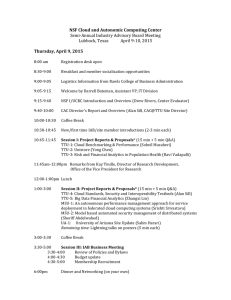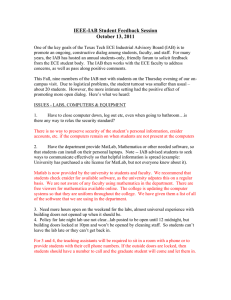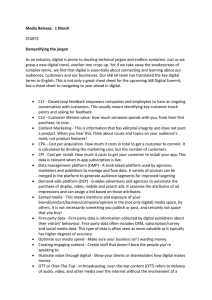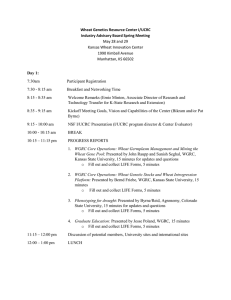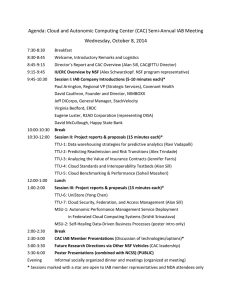Introduction
advertisement
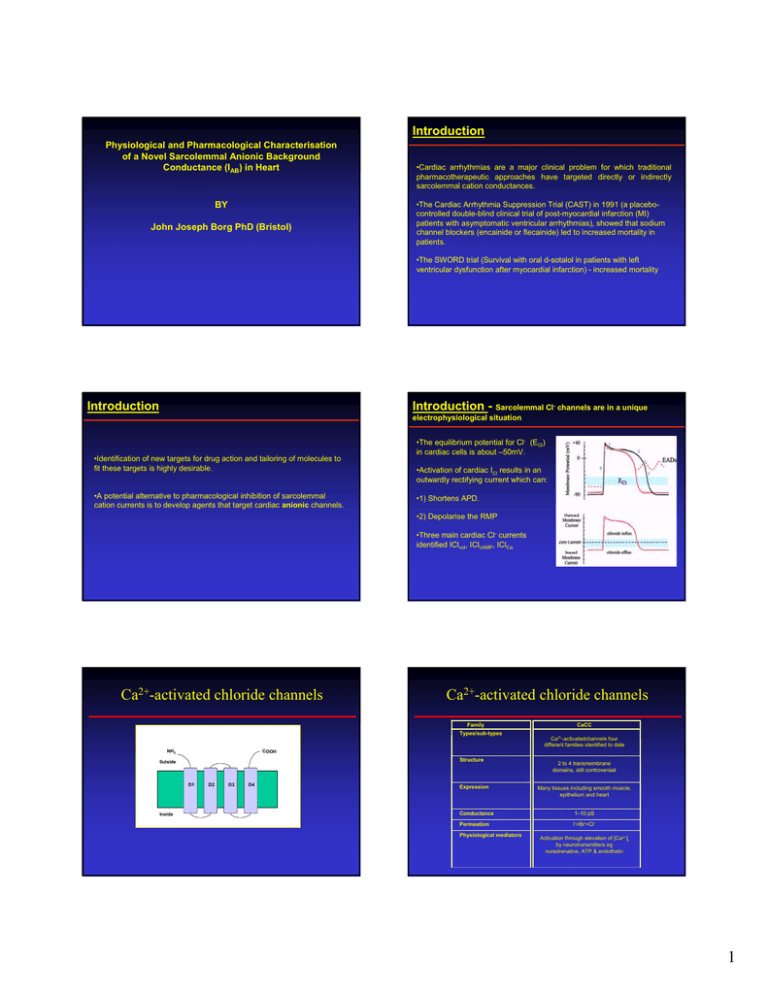
Introduction Physiological and Pharmacological Characterisation of a Novel Sarcolemmal Anionic Background Conductance (IAB) in Heart BY John Joseph Borg PhD (Bristol) •Cardiac arrhythmias are a major clinical problem for which traditional pharmacotherapeutic approaches have targeted directly or indirectly sarcolemmal cation conductances. •The Cardiac Arrhythmia Suppression Trial (CAST) in 1991 (a placebocontrolled double-blind clinical trial of post-myocardial infarction (MI) patients with asymptomatic ventricular arrhythmias), showed that sodium channel blockers (encainide or flecainide) led to increased mortality in patients. •The SWORD trial (Survival with oral d-sotalol in patients with left ventricular dysfunction after myocardial infarction) - increased mortality Introduction Introduction - Sarcolemmal Cl- channels are in a unique electrophysiological situation •Identification of new targets for drug action and tailoring of molecules to fit these targets is highly desirable. •A potential alternative to pharmacological inhibition of sarcolemmal cation currents is to develop agents that target cardiac anionic channels. •The equilibrium potential for Cl- (ECl) in cardiac cells is about –50mV. •Activation of cardiac ICl results in an outwardly rectifying current which can: •1) Shortens APD. •2) Depolarise the RMP •Three main cardiac Cl- currents identified IClvol, IClcAMP, IClCa Ca2+-activated chloride channels Ca2+-activated chloride channels Family Types/sub-types NH2 COOH Structure 0utside D1 Inside CaCC Ca2+-activatedchannels four different families identified to date D2 D3 D4 Expression 2 to 4 transmembrane domains, still controversial Many tissues including smooth muscle, epithelium and heart Conductance 1–10 pS Permeation I->Br->Cl- Physiological mediators Activation through elevation of [Ca2+]I by neurotransmitters eg noradrenaline, ATP & endothelin 1 ClC choride channels ClC - voltage gated chloride channel family Family ClC Types/sub-types Outside L C B I H D E F M N Q R A NH2 COOH CBS 2 Each CLC subunit has 17 intramembrane α helices labelled A to R where helix A is cytoplasmic P K G Structure O J Expression Virtually ubiquitous CBS 1 Conductance Physiological mediators CFTR (cystic fibrosis transmembane regulator) Family Outside CFTR Structure 12 transmembrane domains Expression Epithelium, heart NBD2 COOH Conductance Physiological mediators Introduction - Sarcolemmal Cl- channels are in a unique •The equilibrium potential for Cl- (ECl) in cardiac cells is about –50mV. •Activation of cardiac ICl results in an outwardly rectifying current which can: •1) Shortens APD. •2) Depolarise the RMP •Three main cardiac Cl- currents identified IClvol, IClcAMP, IClCa 5–8 pS Br->Cl->I- Permeation electrophysiological situation Only one known several splice variants D D D 10 11 12 R NBD1 NH2 Cell swelling, intracellular pH, depolarisation, hyperpolarisation, intracellular Ca2+ CFTR - Cystic fibrosis transmembrane regulator Types/sub-types D7 D8 D 9 1–9 pS I->Br->Cl- Permeation D1 D2 D3 D4 D5 D6 ClC1-7, Ka & Kb in total nine members identified in mammals Phosphorylation by PKA, ATP hydrolysis at Regulatory domain Hypothesis Therefore, activation of cardiac Cl- currents may affect action potential duration (APD), and in disease states could contribute to pathological changes in cardiac cell function. These observations have led to the formulation of the following hypothesis. Inhibition of Cl- conductances may lead to a prolongation of repolarisation and an increase in the length of the refractory period: effects which should provide inhibitors of chloride channels with an anti-arrhythmic profile similar to that of Class III anti-arrhythmic agents. 2 Introduction - IAB a novel background conductance in the heart Introduction - Aims Recently, a novel anionic background conductance termed -IAB- was identified in rat ventricular myocytes and suggested to play a role in APD (Spencer et al., 2000). •To study the physiological relevance of this current by characterising IAB in a species with a ventricular AP closer in profile to that of the human (ie the guinea pig). Thus the modulation of IAB could have potential clinical relevance. •To investigate that IAB is pharmacologically distinct from other cardiac chloride conductances. In essence: Inhibition of repolarising current - a Class III anti-arrhythmic approach. •To determine the contribution of IAB in regulating the cardiac AP. Increasing the magnitude of a repolarising current shortens the cardiac AP -might lead to re-entry of arrhythmias The patch-clamp recording technique •To investigate whether the modulation of IAB affects the cardiac AP. •To investigate whether chronic disease states affect IAB. Whole cell recording patch-electrode cell-attached patch cell whole-cell negative pressure lift lift inside-out patch outside-out patch Methods - Electrophysiology (Whole Cell) IAB ICl,vol Methods - Electrophysiology (whole Cell) - APs were recorded at 35 °C ICl,cAMP Electrode AgCl Bath Electrode Na+, Ca2+ and K+-free, Cs+, [Cl]i was 21 mM Na+, Ca2+ and K+-free, Cs+, [Cl]i was 21 mM Na+, Ca2+ and K+-free, Cs+, [Cl]i was 21 mM K+, Na+, Ca2+, K2ATP, glucose. [Cl]i was 123 mM Glass pipette Myocyte Na+, Ca2+and K+-free NMDG-Cl-, Aspartate, NO3- or ICs+, TEA+, Ba2+, and Cd2+ [Cl]o was 150 mM , [NO3-]o , [Aspartate]0 & [I-]o was 135 mM. Ca2+and K+-free. Hyposmotic external solution prepared by omitting 140 mM sucrose. Final osmolarity was 145 ± 5 mOsm, [Cl]o was 78 mM. ICl,cAMP – K+-free. ICl,cAMP activated with Forskolin (1 μM), [Cl]o was 153 mM. Normal Tyrode’s, NaCl, KCl, CaCl2, MgCl2. Isotonic. For anion substitution experiments NaCl was replaced with NaAspartate or NaNO3-. [Cl]o was 155 mM , [NO3-]o & [Aspartate]0 & [I-]o was 134 mM. 3 Results - IAB - biophysical properties (guinea pig VM) +80 mV A B C -80 mV Cl- (b) ASP (a) 500 ms NO3- (c) On the distinct nature of IAB 1 pA/pF 500 ms D NO3- (c-a) E Cl- (b-a) 1 pA/pF 500 ms Results - Further biophysical Characterisation of IAB in guinea pig VM (A) 1 Inward rectification of IClC-2 at -ve potentials Im (pA/pF) -90 mV Time-dependent activation of IClC-4 at +ve potentials Time-dependent inactivation of ICl,vol at +ve potentials (B) + 70 mV - 50 mV - 50 mV NO3- NO3- (n=4) 500 ms Aspartate Erev (mV) Relative Permeability -36.38 ± 0.8 -42.22 ± 2.77 -51.7 ± 0.89 500 ms 0 -0.1 -70 -1 -80 mV I- (n=4) 0.1 0 ClINO3- +80 mV Cl- (n=5) 0.2 Im (pA/pF) Differences between IAB and other Cl- currents • instantaneous-activation of current (unlike IClC,4) • no time-dependent inactivation at +ve potenntials (unlike Icl,cvol) • Outwardly rectifying (IClC,2 is inwardly rectifying) • Carried by different anions (N03- is a better charge carrier than Cl-; this differentiates IAB from the voltage-gated CLC-4 channels) -50 Vm (mV) -30 -10 Using the modified GHK eqn: NO3->I->Cl- 1.57 ± 0.17 2.05 ± 0.19 Permeability sequence of IAB is different from that of ICl,cAMP (Br->Cl->I->F-); ICl,vol (SCN->I->NO3->Br>Cl->F-) and ICl,Ca (SCN->I->Br->Cl-) Representative IAB current traces elicited by depolarising voltage-ramps Results - IAB (NO3- - sensitive currents recorded from guinea pig VM, rat atrial and VM) + 70 mV A B -90 mV 0.6 500 ms 0.4 0 ASP (a) pA/pF pA/pF NO3- (b) Nitrate-sensitive difference current 0.2 NO3- (b-a) pA/pF 1 1.0 - 50 mV - 50 mV No significant difference was observed between groups (P>0.05; ANOVA) 0.5 0 -1 -75 -50 -25 0 25 50 75 Vm (mV) 0.0 Guinea pig VM Rat VM (n=9) (n=4) Rat AM (n=5) These results suggest that IAB night be homogeneously distributed in heart. This is not the case with ICl,vol and ICl,cAMP 4 Results - IAB (Effect of hypertonic conditions, PKA and PKC inhibition and ~20 nM intracellular Ca2+ on IAB in guinea pig VM ) + 70 mV - 50 mV -90 mV 1 Ca2+and pA/pF NO3- (b) Na+, K+-free NMDG-NO3-, Aspartate. Hypertonicity ↑ with 63 mM Sucrose 0 B 1.0 - 50 mV 0.6 500 ms ASP (a) 0.4 0.2 NO3- (b-a) 0.0 -1 pA/pF A pA/pF Na+, Ca2+, K+, Mg-ATP, trisGTP -free, 1 mM Cs EGTA, H7-DHC (6 μM) Results - IAB (Effect of hypertonic conditions, PKA and PKC inhibition and calcium chelation on IAB in guinea pig VM ) -75-50-25 0 25 50 75 Vm (mV) 0.0 These results suggest that IAB is not ICl,vol, ICl,cAMP and ICl,Ca Results - I AB 0.5 (Effect of GTP-y-S (intracellular) on IAB in guinea pig VM ) CTRL (n=9) intracellular H7-DHC hypertonic conditions (n=4) Results - IAB’s Pharmacology is distinct from other Cl- currents in the heart + 70 mV 1 These results suggest that IAB is not sensitive to activation by g-proteins which differentiates IAB from ICl,vol, and ICl,cAMP 500 ms pA/pF 0.4 ASP (a) 0.2 NO3- (b-a) B 0.6 DIDS 50 μM 0.4 0.2 NO3- TAMOX 100 μM 0.4 0.2 NO3- 0.0 0.0 -0.2 -75 -50 -25 0 25 50 75 Vm (mV) -0.2 -75 -50 -25 0 25 50 75 Vm (mV) 0.0 -1 For A and B similar results were observed in five myocytes • DIDS reported to inhibit ICl,vol, ICl,Ca •Tamoxifen reported to inhibit ICl,vol -75 -50 -25 0 25 50 75 (mV) C pA/pF 0 CTRL exp showing that GTP-y-S potentates ICa,L in guinea pig VM, and therefore GTP-y-S is active under these experimental conditions -2 -4 -6 0 mV 500 ms -40 mV Results - IAB’s Pharmacology is distinct from other Cl- currents in the heart 0.6 pA/pF pA/pF NO3- (b) 0 A 0.6 pA/pF -90 mV B - 50 mV - 50 mV pA/pF A Results - IAB’s Pharmacology is distinct from other Cl- currents in the heart - The search for Novel modulators ! Type I pyrethroids CTRL Test agent O O O O F3C Cl O 0.4 Bioallethrin 0.2 0.0 O F3 C Cl Gd3+ (1 mM) (n=5) Picrotoxin (1 mM) (n=5) Chlorotoxin (1 µM) (n=4) • Gd3+ reported to inhibit the voltage-gated chloride channels CLC-0 & CLC-1, ICl,vol, the nonselective cation channel (INSC), the sodiumcalcium exchanger current (INCX]) and the stretch-activated cation current (ISAC) • Picrotioxin reported to inhibit ligand-gated Clcurrents (GABAA) •Chlorotoxin reported to small conductance Clchannels F O F Bifenthrin O O O N F O F Tefluthrin Tetramethrin Type II pyrethroids Cl Cl O CN O F O Cyfluthrin Cl Cl O CN O O CN O O O Cypermethrin Fenpropathrin Pyrethroids have been shown to decrease the rate of taurine efflux in C6 and HELA cells Disparate chemical pharmacophores (stereo chemistry) 5 Results - Effects of Pyrethroids on IAB B + 70 mV - 50 mV - 50 mV -90 mV 1.0 0.8 CYP (c) NO3- (b) ASP (a) 0 0.8 0.4 0.2 NO3- (b-a) 0.0 -1 -75 500 ms Anomalous mole fraction effect 1.2 NO3 ASP - -50 -25 0 25 Vm (mV) 50 FENP CYP TEF 10 µM CYP EC50 (µM) nH 3.01 ± 0.1 7.02 ± 0.2 4.0 ± 0.3 1.0 ± 0.3 0.9 ± 0.3 2.1 ± 0.9 0.6 All three compounds maximally activated IAB to the same extent (P>0.05; ANOVA) 75 0.4 ASP 1.0 pA/pF (FENP) (CYP) (TEF) 1.0 CYP (c-a) 0.6 pA/pF pA/pF 1 pA/pF A Results - Effects of Pyrethroids on IAB +60 mV 0.8 0.2 0.01 0.1 1 10 Concentration (μM) 100 0.6 n>3 for each data point 0.4 0 200 400 600 800 Time (s) 1000 1200 1400 Results - Effects of 300 µM TET on IAB Results - Effects of Pyrethroids on anion insensitive residual current This exp is a ctrl showing that CYP, FENP and TEF do not activate an anion insensitive residual current or a leak current. 0.4 Increase in Im (pA/pF) pA/pF 0.6 0.2 0.0 CTRL 300 µM TET (n=5) 0.10 No significant difference was observed in the absence and presence of pyrethroid agents (P>0.05; Student’s t-test) 0.05 0.0 This exp shows that not all pyrtheroids effect IAB. Therefore differences in the structures between pyrethroids might hint to a Pharmacophore. CYP (n=5) FENP (n=6) TEF (n=5) Results - Effects of 100 µM FENP, CYP and TET on ICl,vol (A) -60 mV 2 HYPO + FENP ISO 5s -60 -40 -20 -2 20 40 Vm (mV) ** 4 2 60 0 (B) (n=5) (C) pA/pF Note: in Guinea pig VM only ICl,vol and ICl,cAMP have been recorded. HYPO 4 HYPO + CYP HYPO 4 pA/pF -50 mV pA/pF +60 mV pA/pF Are the effects of pyrtheroids on IAB selective? Or do they have other effects on other Cl- currents (ICl,vol and ICl,cAMP) ? ISO HYPO HYPO + FENP 2 HYPO + TET HYPO 4 2 ISO -60 -40 -20 20 -2 40 Vm (mV) 60 ISO -60 -40 -20 20 -2 40 60 Vm (mV) 6 Results - Effects of FENP and DIDS on ICl,vol Results - Effects of 100 µM FENP, CYP, TET, TEF on ICl,cAMP CTRL FSK FSK + CYP CTRL + CYP (B) Isotonic Hypotonic Hypotonic & DIDS 50 µM 1 (n=4) 10 Concentration (µM) 2 CTRL + CYP CTRL 3 -60 2 20 40 Vm (mV) * 4 2 60 0 1 (n =5) (n=5) FENP inhibits ICl,vol with an IC50 of 26.2 ± 0.3 µM and a Hill coefficient of 2.1 ± 0.1 -20 -2 0 100 -40 B) shows a CTRL exp where ICl,vol is inhibited by DIDS. This shows that under these conditions ICl,vol has been activated and not a hypotonically induced cation current. B pA/pF (n=4) 0 FSK + CYP FSK 4 -60 -40 -20 4 FSK 2 CTRL II CTRL I -2 20 40 pA/pF (n=5) 50 (pA/pF % Inhibition (n=3) pA/pF (n=5) 100 pA/pF A (A) CTRL FSK CTRL 4 2 60 0 Vm (mV) (n =4) B is a CTRL exp showing that upon removing FSK from perfusate ICl,cAMp reverses back to CTRL levels Results - Effects of 100 µM FENP, CYP, TEF & TET on background currents after FSK was removed from the bath solution Results - Effects of glibenclamide on ICl,cAMP Control (n=5) Forskolin 1 µM (n=5) Forskolin 1 µM + Glibenclamide 100 µM (n=5) 100 shows a CTRL exp where ICl,cAMP is inhibited by GLB. This shows that under these conditions IClcAMP has been activated 3.0 60 Im (pA/pF) % Increase 80 40 20 0 CYP (n=5) FENP (n=5) TET (n=4) TEF (n=4) 2.0 1.5 1.0 0.5 Although comparisons of this exp with the effects of pyrethroids on nitrate sensitive currents (IAB) cannot be made (due to the different recording conditions used to isolate the currents), a common pattern of pyrethroid activity on basal currents can be observed Results - Effect of anion substitution on APs 2.5 0.0 Results - Effect of 10 µM TEF on APs A 100 155 mM [Cl-]0 134 mM [NO3-]0 Anion substitution exps identical to voltageclamp exps show that IAB can shorten APD B 155 mM [Cl-]0 155 mM [Cl-]0 + TEF 134 mM [ASP]0 134 mM [ASP]0 + TEF Vm (mV) 50 0 -50 -100 250 ms APD90 by ~21% 250 ms APD90 by ~21% 250 ms APD90 by ~52% A shows that TEF shown to increase IAB (therfore increasing an outwardlyrectifying current) shorten APD. B shows that when IAB is inhibited (by replacing Cl- with ASP) TEF does not shorten APD. - lengthening of APD is due to TEF’s reported effect of slowing INa inactivation 7 Results - Incorporation of IAB into a guinea pig ventricular cell model Reports have shown that anion substitution and pyrethhroid agents may affect sarcolemmal cationic conductances 100 Control IAB incorporated 0.7 50 •ASP has been shown to inhibit ICa,L 0.6 experimental 0.5 simulation •Some pyrethroids shown to modulate cardiac INa and ICa,L & ICa,T pA/pF Vm (mV) 0.4 0 0.2 0.1 -50 •Therefore to overcome the limitation that the interventions used during AP Exps were not entirely selective for IAB, AP simulations were conducted 0.3 0.0 -0.1 -100 250 ms -80 -40 0 40 Vm (mV) 80 APD90 by 12 % (34 ms) This result is important because it shows that a background Cl- conductance can modulate APD Results - Incorporation of IAB into a guinea pig ventricular cell model •Incorporation of IAB in the ventricular AP model suggests that IAB plays a role in APD. •IAB affected APD by a similar magnitude therapeutically used Class III anti-arrhythmic agents sotalol and amiodarone at clinically relevant serum concentrations. Results obtained show that Increasing IAB can reduce APD • Shortening of APD shown to precipitate arrhythmias VT, VF, short QT syndrome •Sotalol increases APD90 by 20 to 40 ms (Groh WJ et al., 1995), •Amiodarone increases APD90 by 12 to 15 ms in rabbits (Kirchhof P et al., 2003) •1st time that a background Cl- current has been incorporated into a guinea pig ventricular AP model. •Routine incorporation of IAB in ventricular AP models Results - Pyrethroids are pro-arrhythmic 1.6 FOC (arb) •Diabetes and Hypertension have been show to induce cardiac remodeling of ion channels TEF C 1.4 B CTRL 1.8 % CV PCCF (arb) A Results - Does disease affect IAB 1.5 CTRL Test Agent * * * 1.0 0.5 0 400 Time (s) CTRL 800 1200 0.0 FENP CYP TEF TET TEF • Decreased expression of K+ channels have been suggested to result in the morphological changes in the AP As suggested by AP studies pyrethroids are pro-arrhythmic 1.6 1.3 1 (s) 8 Results - Does disease affect IAB 0.6 Summary The present study has shown that: (CTRL) (Disease) pA/pF •IAB was found to exist in guinea pigs. 0.4 0.2 0.0 Obesity and Diabetes Hypertension This exp shows that unlike other K+ channels the current density of IAB is not affected by diabetes and hypertension •This is important as guinea pig ventricular myocyte electrophysiology is similar to that of the human, and therefore IAB could be present in humans. Thus being a potentially new pharmacological target in the heart. •IAB was found to be a time-independent, outwardly rectifying current that is highly permeable to NO3-. IAB has a relative permeability sequence of NO3->I->Cl->aspartate. Summary •IAB was not blocked by DIDS, TAMOX, Gd3+, Picrotoxin and chlorotoxin, or hypertonicity, or by the non-selective protein kinase inhibitor H7-DHC 6 μM (inhibits both PKA and PKC). •IAB has a distinct pharmacology from the currently identified Clconductances in the heart. •Collectively the results suggest that the molecular identity underlying IAB is distinct to other Cl- currents in the heart. •Activators of IAB indicate its potential value as a novel pharmacological target in the heart: •Inhibition of IAB could be of value in producing a modest Class III antiarrhythmic effect. 9
